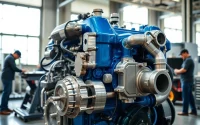Understanding the Role and Benefits of Compressed Air Receivers in Industrial Applications
What is a Compressed Air Receiver?
Definition and Function
A compressed air receiver, commonly referred to as an air tank or air receiver tank, is an essential component in compressed air systems. Its primary function is to store compressed air and to regulate the supply to pneumatic tools and equipment. By acting as a buffer between the air compressor and the devices using the air, it ensures a steady flow of compressed air, even during fluctuating demand times. This characteristic is crucial particularly in industrial settings where pneumatic equipment may require varying amounts of air pressure to function optimally.
Key Components
The key components of a compressed air receiver typically include:
- Tank: The main storage vessel cylinder, which can be horizontal or vertical depending on space and requirements.
- Pressure Relief Valve: This valve prevents over-pressurization of the tank by releasing excess air when necessary.
- Locate Sensors: These monitor pressure levels in the tank to ensure optimal performance.
- Drain Valve: It allows moisture to escape from the bottom of the tank, preventing water accumulation that can rust the tank and contaminate the air supply.
Types of Compressed Air Receivers
Compressed air receivers come in various types each suited for different applications:
- Vertical Receivers: These are often used when space is limited. Their upright design maximizes storage capacity without occupying much floor space.
- Horizontal Receivers: These provide a larger volume of compressed air and may be easier to maintain, but they require more floor space.
- ASME Certified Receivers: Tanks that comply with the American Society of Mechanical Engineers (ASME) standards, indicating that they are built to withstand high pressure and ensure safety.
Why Use a Compressed Air Receiver?
Benefits of Compressed Air Storage
The utilization of compressed air storage systems provides several advantages:
- Demand Management: A receiver functions as a buffer that absorbs fluctuations in air demand, ensuring consistent performance of equipment during peak usage times.
- Pressure Stabilization: The air receiver helps to stabilize the pressure in the system, preventing unnecessary cycling of the compressor and thus lengthening its lifespan.
- Improved Efficiency: By efficiently managing the air supply, organizations can improve the overall efficiency of their pneumatic systems, contributing to reduced operational costs.
Improving System Efficiency
Compressed air systems are often criticized for their inefficiencies. By incorporating a properly sized air receiver, air pressure fluctuations are minimized, allowing for elevated operational efficiency. The air receiver compensates for short-term increases in air demand without requiring the compressor to respond immediately. This not only leads to energy savings but also extends the life of the equipment.
Enhancing Air Quality
Another significant benefit of a compressed air receiver is its role in improving air quality. By holding compressed air temporarily, moisture can condense and settle at the bottom of the tank, helping to ensure that drier, cleaner air is available to downstream equipment. Moreover, having a drain valve allows users to remove impurities such as moisture and oil to maintain high-quality air, which is crucial for many applications.
How to Select the Right Compressed Air Receiver
Factors to Consider
Selecting the right compressed air receiver involves several vital considerations, including:
- Application Requirements: Understanding the specific needs of machinery and tools is essential. Evaluate operational demand, airflow, and pressure requirements.
- Space Availability: Assessing available installation space can affect whether to choose a vertical or horizontal receiver.
- Compliance Standards: Ensure that the receiver meets local safety and compliance regulations, particularly if it is necessary for industry-specific standards such as ASME certification.
Sizing and Capacity Considerations
Determining the appropriate size for a compressed air receiver is crucial for optimal performance. A detailed assessment should consider:
- Peak Demand: Identify the peak air demand which corresponds to the maximum flow requirement of the application.
- Run Time: Consider the run time of the compressor. For longer operation, larger storage capacity may be needed to supply air during compressor downtime.
- Air Consumption: Calculate average air consumption in cubic feet per minute (CFM) to estimate the necessary receiver volume.
Material Types and Durability
Compressed air receivers come in various materials including:
- Steel: The most common material, known for excellent strength and durability, suitable for high-pressure applications.
- Aluminum: Lighter and resistant to corrosion, yet typically more expensive. Suitable for applications requiring mobility.
- Composite Materials: Often used in specialized applications, these materials offer chemical resistance and reduced weight.
Installation and Maintenance of Compressed Air Receivers
Installation Best Practices
Installing a compressed air receiver correctly is vital to its operation. Here are some best practices:
- Location: Place the receiver in a well-ventilated area to prevent overheating and ensure easier access for maintenance.
- Piping Configuration: Use appropriate pipe sizes to maintain pressure and flow rates, minimizing bends and restrictions.
- Vibration Isolation: Incorporate vibration dampeners to reduce noise and wear on the system.
Regular Maintenance Checking
Regular maintenance checks are essential for the longevity of the compressed air receiver. Key maintenance tasks include:
- Visual Inspections: Check for leaks, corrosion, and any visible signs of damage.
- Pressure Checks: Regularly monitor pressure levels to ensure the system is functioning correctly.
- Drainage: Regularly drain accumulated moisture and condensation from the tank to prevent damage and contamination.
Common Issues and Troubleshooting
Some common issues associated with compressed air receivers include:
- Over-Pressurization: Ensure that pressure relief valves and cutoff switches are operational to prevent damage or hazards.
- Water Accumulation: Regular drainage can help prevent moisture buildup, which can rust interior surfaces and contaminate air quality.
- Pressure Drops: Inspect the system’s piping for leaks or blockages that could disrupt flow.
Future Trends in Compressed Air Receiver Technology
Smart Systems and Monitoring
The integration of smart technology into compressed air systems is paving the way for enhanced monitoring and management of receivers. This includes:
- IoT Sensors: Sensors that monitor pressure, temperature, and humidity in real-time, allowing predictive maintenance and reducing downtime.
- Remote Monitoring: Systems that provide operators with the capability to assess the receiver’s performance remotely, thus improving responsiveness.
Energy Efficiency Improvements
Future developments in compressed air technology will focus on energy efficiency innovations. Examples include:
- Variable Speed Drives: These allow compressors to operate at different speeds, maximizing efficiency based on air demand.
- Regenerative Air Dryers: New dryer technologies that recycle energy during operation, maintaining dry air supply while reducing overall energy costs.
Sustainability and Eco-Friendly Practices
As industries increasingly prioritize sustainability, compressed air receivers will evolve to meet these demands. This includes:
- Enhanced Material Use: Utilizing recyclable and less environmentally harmful materials in the construction of air receivers.
- Waste Reduction Strategies: Systems designed to minimize waste in both compressed air production and usage, emphasizing green technology.


